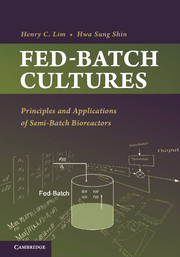Book contents
- Frontmatter
- Contents
- Preface
- Acknowledgments
- 1 Introduction to Fed-Batch Cultures
- 2 Idealized Reactors and Fed-Batch Reactors
- 3 Maximization of Reaction Rates and Fed-Batch Operation
- 4 Phenomena That Favor Fed-Batch Operations
- 5 Classification and Characteristics of Fed-Batch Cultures
- 6 Models Based on Mass Balance Equations
- 7 Non–Equation-Based Models
- 8 Specific Rate Determination
- 9 Optimization by Pontryagin's Maximum Principle
- 10 Computational Techniques
- 11 Optimization of Single and Multiple Reactions
- 12 Optimization for Cell Mass Production
- 13 Optimization for Metabolite Production
- 14 Simple Adaptive Optimization
- 15 Measurements, Estimation, and Control
- 16 Feasibility Assessment and Implementable Feed Rates
- Index
- References
12 - Optimization for Cell Mass Production
Published online by Cambridge University Press: 05 April 2013
- Frontmatter
- Contents
- Preface
- Acknowledgments
- 1 Introduction to Fed-Batch Cultures
- 2 Idealized Reactors and Fed-Batch Reactors
- 3 Maximization of Reaction Rates and Fed-Batch Operation
- 4 Phenomena That Favor Fed-Batch Operations
- 5 Classification and Characteristics of Fed-Batch Cultures
- 6 Models Based on Mass Balance Equations
- 7 Non–Equation-Based Models
- 8 Specific Rate Determination
- 9 Optimization by Pontryagin's Maximum Principle
- 10 Computational Techniques
- 11 Optimization of Single and Multiple Reactions
- 12 Optimization for Cell Mass Production
- 13 Optimization for Metabolite Production
- 14 Simple Adaptive Optimization
- 15 Measurements, Estimation, and Control
- 16 Feasibility Assessment and Implementable Feed Rates
- Index
- References
Summary
Optimization of bioprocesses is very important because these processes require capital-intensive plants, yield products that are low in concentration, and sometimes use expensive raw materials. The objective of bioprocess optimization is to maximize the profit of the process. More specifically, it frequently involves the maximization of the volumetric productivity, metabolite concentration, conversion, or yield and minimization of capital and operating costs or time to achieve a desired conversion.
Vital to the success of optimization methods is the development of mathematical models that describe adequately the behavior of the process under various conditions and therefore provide quantitative relationships between the outcome (outputs) and the manipulated variables (inputs) of the process. Some models contain a number of process parameters that need to be determined directly or indirectly from experimental data. The optimal control is aimed at achieving process optimization. A model being the foundation for process optimization and control, any increase in complexity of the model is justified only if it results in a significant improvement in the process performance. In light of the complex nature of the microbial and cellular processes, improved on-line measurement and data acquisition methods are of central importance to optimization of these bioprocesses. In this chapter, we deal with the optimization of bioreactors that are modeled by ordinary differential equations, which results from the material balances of species involved: the cells, substrates, products, intermediates, nutrients, various enzymes, and other chemical entities, as we have seen in previous chapters. In this chapter, we consider an impulse optimization through the application of PMP, which is most well suited for processes described by a set of ordinary differential equations.
- Type
- Chapter
- Information
- Fed-Batch CulturesPrinciples and Applications of Semi-Batch Bioreactors, pp. 227 - 297Publisher: Cambridge University PressPrint publication year: 2013



